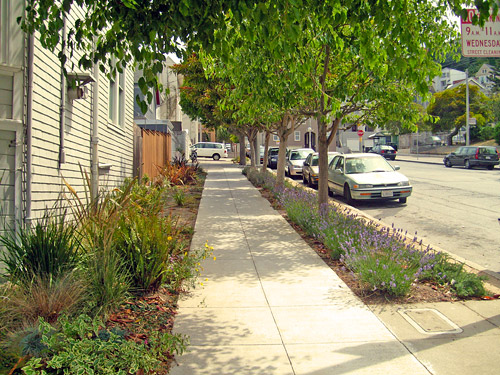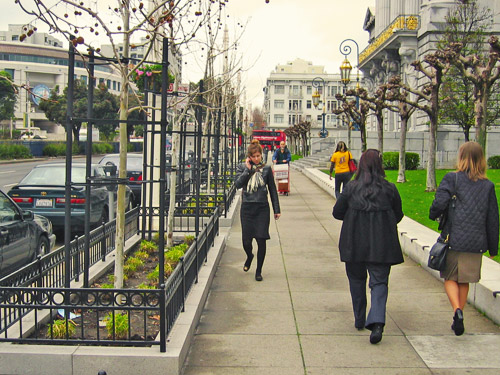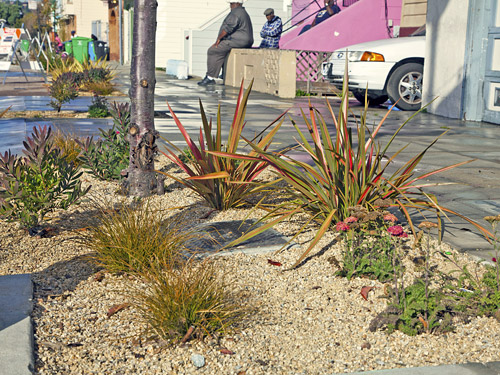See also: DPW Sidewalk Landscape Homepage
Landscaped sidewalks look great, provide habitat for birds and butterflies, reduce stormwater runoff, improve neighborhood livability and increase property values.
Sidewalk landscaping is a simple and inexpensive street improvement that individual residents and property owners can make on their own.
Process Overview
Sidewalk landscaping may be installed by small property owners, by major new development or as part of corridor-wide improvements.
Applicants are encouraged to apply as multiple property owners along a block or neighborhood to enhance the project’s benefits and lower costs to the applicants. Talk to your neighbors about putting together a joint sidewalk landscaping application.
See Building Neighborhood Support
Sidewalk landscaping requires a Sidewalk Landscaping Permit from DPW. A Sidewalk Landscape Permit grants permission to replace a portion of the concrete sidewalk with landscaping. A permit is required to ensure that the landscaping in sidewalk areas is properly constructed and maintained in order to maximize environmental benefits, protect public safety and limit conflicts with infrastructure.
Sidewalk landscaping may be built as a standalone feature, or in coordination with other streetscape features, such as street trees, bioretention planters (rain gardens), or permeable paving. Street trees are encouraged along with sidewalk landscaping where they are currently lacking.
Sidewalk Landscaping Permit – Application
See Permit Process for more information.
Official Codes & Documents
- Better Streets Plan (street design guidelines)
- DPW Sidewalk Landscape Homepage
- Sidewalk Landscape Permit Guidelines
- Stormwater Design Guidelines
(The SFPUC’s guidelines for design of stormwater management features) - Stormwater Design Guidelines Appendix A (Stormwater management tools for specific applications)
- SFPlantfinder (Sortable database of recommended plants for all planting conditions, soils, habitat, and water use.)
Design Guidelines
Location
Street types: Downtown Commercial; Commercial Throughway; Neighborhood Commercial; Downtown Residential; Residential Throughway; Neighborhood Residential; Mixed Use; Parkway; Park Edge; Boulevard; Alley; Shared Public Way; Paseo
Sidewalk zones: Frontage; Furnishings; Extension
See Sidewalk Landscape Permit Guidelines for full list of required design features
Additional Urban Design Guidelines
Species Selection
In addition to landscaping, street trees are strongly encouraged in sidewalk planting strips if planting areas are of sufficient width. Plant species and layout are subject to DPW Bureau of Urban Forestry’s staff approval.
Planting strips should be a minimum of 3 feet wide along a street where trees are to be planted.
See Street Trees
Most plants are acceptable for sidewalk landscaping; however, ivy and other invasive groundcovers should be avoided as they can provide protective cover for pests. Tall, dense bushes and hedges should also be avoided as they can limit visibility and accessibility. Thorny and spiky plants are also not allowed.
Sidewalk landscaping should use drought-tolerant species. Deep-rooted native or drought-tolerant species have many benefits including tolerance to flooding and drought, low or no irrigation needed once established, improving water quality by filtering pollutants, and aerating and increasing the permeability of soils. Native and drought-tolerant species provide wildlife habitat and generally contribute to the health of the soil, and should be considered wherever understory landscaping projects are implemented.
If initial or ongoing irrigation is needed, the project should have access to a metered water source and seek approval from the account holder to use the water service. Contact SFPUC Customer Service to locate water service account information.
All plant species must be approved by DPW.
See Sidewalk Landscaping Recommended Drought Tolerant Plant List
Stormwater Management
Planting strips can be designed to detain, cleanse, and infiltrate stormwater. In more significant storm events, overflow from one planter can be channeled to the next.
Planting Along the Property Line
On streets where there is not enough sidewalk space to install sidewalk landscaping in the furnishing zone or where sidewalk width allows, planting in the frontage zone should be considered. This strategy is particularly relevant at transit stops where sidewalk landscaping otherwise cannot be placed adjacent to the street edge.
Property line planting strips that do not include trees may be as narrow as 6 to 12 inches. These can be designed as cut-outs in the sidewalk for vine plantings, or can be an area used for planter boxes or other containers.
Shallow-rooted landscaping such as groundcovers, grasses and small shrubs should be used to minimize the risk of root damage to building foundations if there is no building setback.
Planting along the property line may also incorporate creeping vines and other similar materials to cover a building façade. Such treatments, called living walls or rain screens, if planned and designed correctly can have stormwater management value as well.
Planting in Medians and in Parking Lanes
Understory landscaping may also be included in parking lane planters and medians as follows:
Medians: Landscaping may be included in medians greater than 4 feet in width, including curbs.
Landscaping in medians is strongly encouraged wherever site conditions allow. Low maintenance, drought tolerant species are encouraged.
A 2 foot wide path clear of plantings should be provided for maintenance workers where possible. Median edge treatments, curbs, and striped areas in the roadway all may count toward this area.
See Median Greening
Parking lane: Landscaping may be included in parking lane planters with the same requirements as landscaping in sidewalk tree basins.
Maintenance
With some exceptions, fronting property owners are responsible for the on-going maintenance and upkeep of sidewalk paving as well as all sidewalk elements directly fronting their property, such as trees, landscaping, and streetscape furnishings. Generally, the City is responsible to maintain roadway paving and other features in the roadway, such as medians.
Typically, if you initiate street or sidewalk improvements, you will be responsible for maintenance of those features. Specific requirements will be described in your permit.
With sidewalk landscaping, residents are required to keep planting beds free of debris and weed, and replace stolen or damaged plants or materials. On average, you may expect to spend approximately ½ hour per week to weed and remove garbage. You may also need to spend 10 to 15 minutes per week in the dry season watering the site, depending on the type of plants.
For a more detailed description of maintenance responsibilities, see Maintenance.










 Copyright © 2015
Copyright © 2015